Light Shadows And Reflections
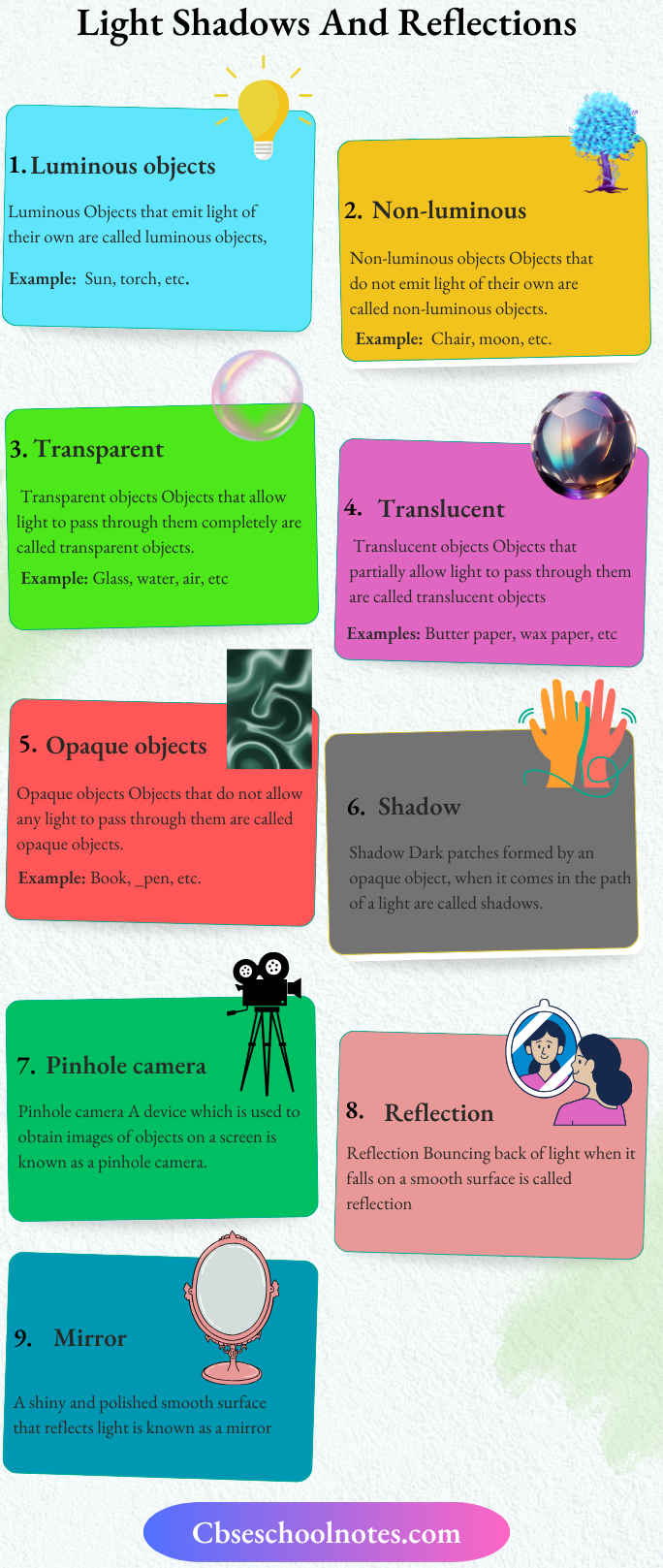
Light Shadows And Reflections Luminous And Non-Luminous Objects
1. Luminous objects:
Luminous objects are those objects which give out or emit their light,
Example: Torch, bulb, the sun, stars, etc.
2. Non-luminous:
Non-luminous objects are those objects which do not emit their light and are visible to us when light from luminous objects falls on them and then reaches our eyes.
Example: Chair, moon, painting, etc.
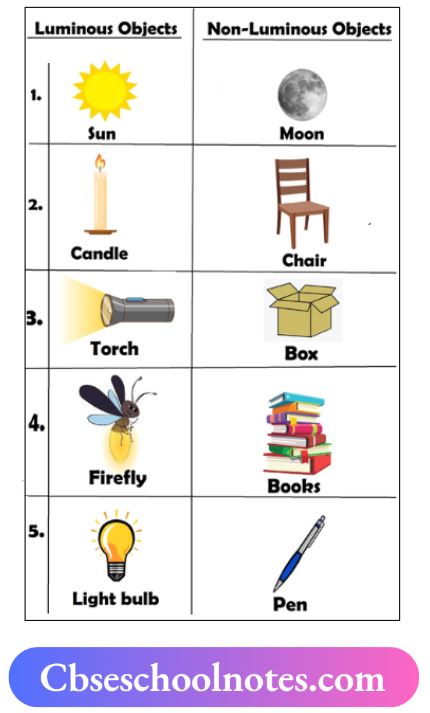
Science Insight:
Moon and planets do not have their light, they reflect the light coming from the sun. So, they are non-luminous objects
Read and Learn More Class 6 Science Notes
Transparent, Opaque And Translucent Objects
The objects which allow us to see through them are called transparent objects.
- In other words, transparent objects are those objects that allow the light to pass through them completely. e.g. Glass, water, air, etc
- The objects which do not allow us to see through them are called opaque objects.
- In other words, opaque objects are those objects which do not allow the light to pass through them.
- Example: Brick wall, cardboard, book, notebook, etc.
- The objects which allow us to see partially through them are called translucent objects.
- In other words, translucent objects are those objects which partially allow the light to pass through them.
Examples: Butter paper, wax paper, greased paper, etc.
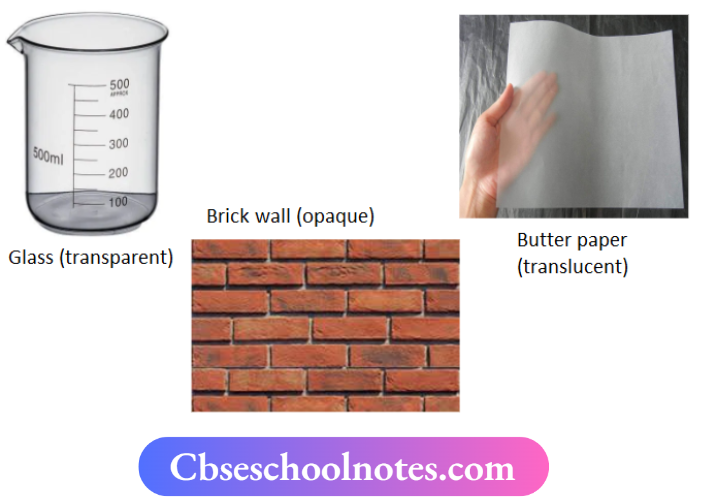
Shadows
The dark patches formed by opaque objects behind them when they come in the path of light are called shadows.
Shadows are formed behind the opaque objects as they do not allow the light to pass through them. Shadows are formed only by opaque objects.
- Shadows of animals and birds hidden in your hand
- Shadow gives us some information about the shapes of objects.
- Sometimes, it can also mislead us because the shape of the shadow is not exactly that of the object.
- In our daily life observations, we have noticed that the criss-cross pattern due to the light coming from window grills is the shadow of grills.
Shadows:
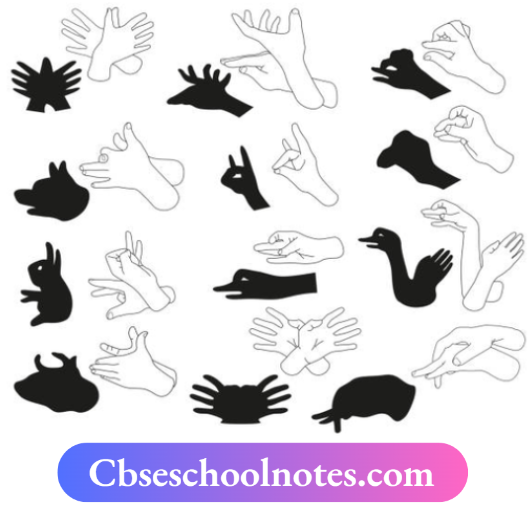
To form a shadow, we need three things:
- A source of light
- An opaque object which comes in the path of light
- A screen on which shadow forms
Science Insight:
The shadow can be seen screen. Grounds, walls of a room, etc., act as observed shadows in daily life.

Some Important Facts about Shadow
- The shadow of an object is formed on the opposite side of the light source.
- Shadow changes its lengths and direction during the day
- As the object moves, its shadow also moves.
- Shadows are always black irrespective of the colour of the object.
- The size and position of the shadow change with a change in the position of the light source or a change in the position of opaque objects

Pinhole Camera
A pinhole camera:
A pinhole camera is a simple device, which is used to obtain an image of a bright object on a screen. A pinhole camera is just a closed box with a tiny hole (pinhole) at one end and a translucent butter paper (screen) on the other end.
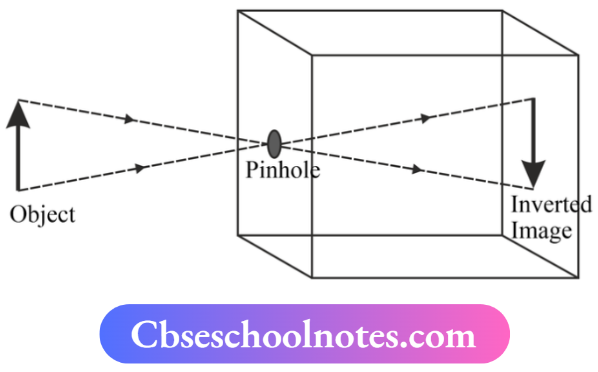
The light comes through the pinhole and the image is formed on butter paper (screen).
A pinhole camera works on the principle that light travels in a straight line.
The image formed by a pinhole camera is inverted and usually smaller in size as compared to the original object.
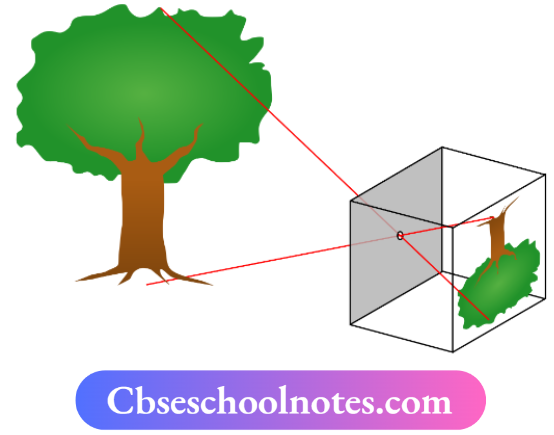
Never Ever Look Directly at The Sun:
An eclipse can be seen using a pinhole camera. When the eclipse is viewed through a pinhole camera, the sun’s image gradually becomes darker as the eclipse starts. We must take a precaution, i.e. not to see eclipse directly with our eyes as it may harm us.
Properties of Image Formed by Pinhole Camera
The image formed in a pinhole camera has the following characteristics
- The image in a pinhole camera is inverted (upside down) as compared to the object.
- The image in a pinhole camera is real (because it can be formed on a screen).
- The image in a pinhole camera is of the same colour as the object.
- The image in a pinhole camera can be smaller than the object, equational to the object or bigger than the object (depending on the distance of the screen from the pinhole).
Get it Right:
Students are often confused between mirror images and pinhole images. The image formed by a plane mirror is the same size as the object but the size of the image formed by a pinhole camera depends on the distance of the pinhole from the screen
Natural Pinhole Camera
- One of the interesting pinhole cameras in nature is the small holes formed by a large number of leaves under the tree.
- When we pass through under such trees, small circular patches seem to be under the tree. These circular patches are pinhole images of the sun.
- The gaps between the leaves act as the pinholes. These gaps are all kinds of irregular shapes but we can see circular images of the sun.
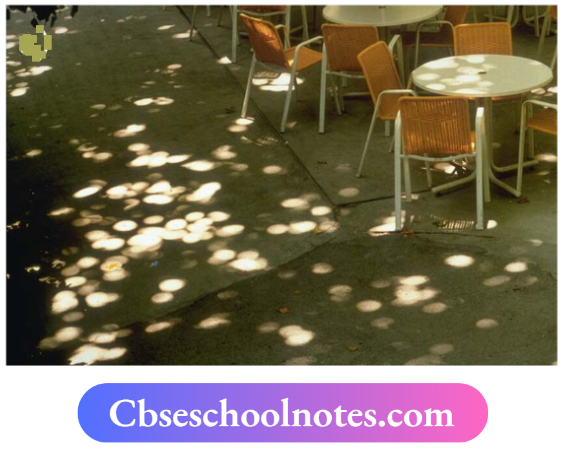
Why image of the sun is not inverted in a pinhole camera?
In our daily life observation, we observe upside-down images of people with a pinhole camera but we can’t see this type of image in the case of the Sun. The reason behind this is the symmetrical and spherical shape of the Sun. The image of the sun is inverted but due to symmetry, the image appears to be the same as that of the original
Light Moves in a Straight Line
When we see a candle through a straight pipe, then it is visible but if we see the candle through a bent pipe, then it is not possible to see it
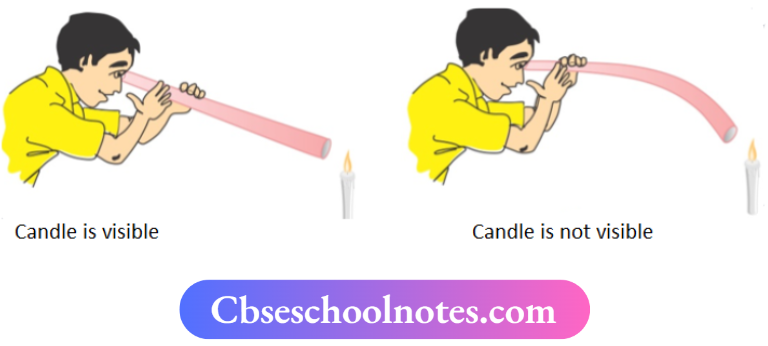
This concludes the light travels in a straight line, so we can say that the formation of pinhole images and shadows is possible only, when light moves in a straight path.
Mirror And Reflection
A mirror is a smooth surface that sends back all the light falling on it. The phenomenon of sending the back of the light by the mirror or other smooth surface is called reflection. Any surface that is well-polished or shiny acts like a mirror.

Science Insight:
The mirror reflects the light at the same angle at which it hits the surface of the mirror. When we look into the mirror, we see our face inside it. The face we see Inside the mirror is the reflection of our face
We also see reflections of other objects that are in front of the mirror. Sometimes, we see reflections of trees, buildings and other objects in a pond or lake.
Reflection of tree In a pond:
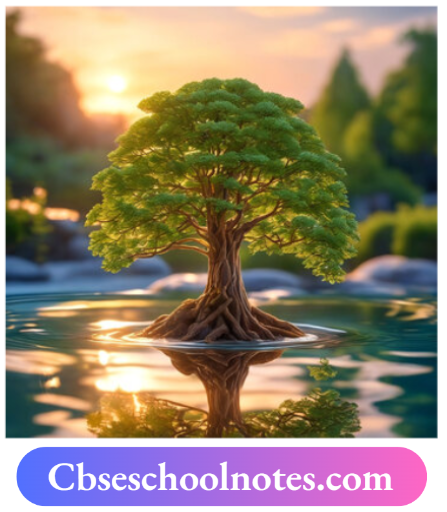
Reflection of the face in a mirror:
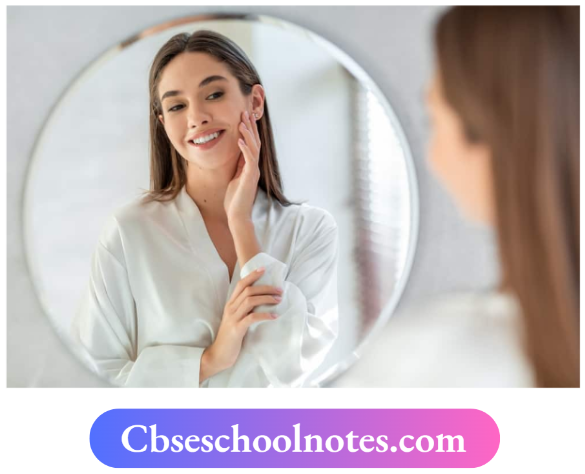
Activity 1
Aim:
To classify the object is opaque, transparent or translucent.
Materials Required:
An eraser, plastic scale, pen, pencil, notebook, a single sheet of paper, tracing paper or a piece of doth, glass, etc.
Procedure
- Hold each object one by one.
- Try to look at something far away, through each object.
- Observe and make a table, whether you can see through the object or not and classify the object according to the observation.
Observing Objects that do Or do not allow light to pass through them:

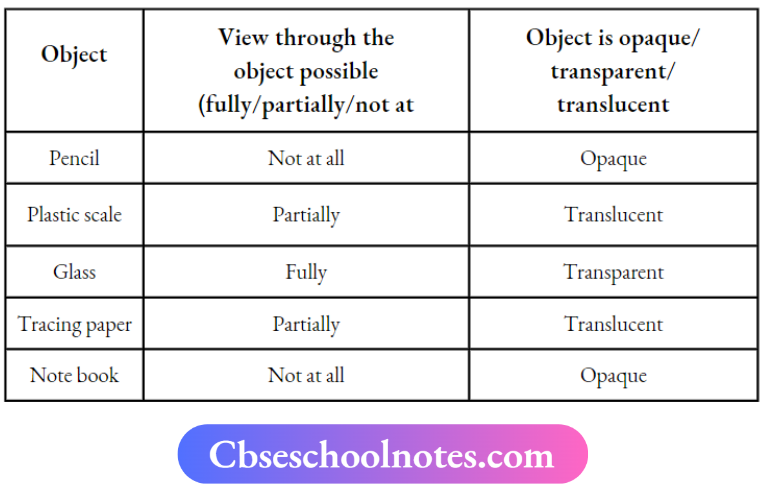
Conclusion:
Through this activity, we have concluded that
- Transparent objects like glass, allow the light to pass through them completely. So, we can see objects through it very clearly.
- Opaque objects like pencils and notebooks do not allow light to pass through them. So, we cannot see the object through it.
- Translucent objects like plastic scales partially allow the light to pass through them, So, we can sec objects through It but not clearly.
Activity 2
Aim:
To identify the opaque objects through its shadow.
Materials Required:
Different opaque objects like flowers, tables, chairs, kites, bulbs, sunlight, and some paper sheets.
Procedure
- Spread the paper sheets on the ground, so it acts as a screen.
- One by one hold each of the objects in the sunlight slightly above the ground and outline the shadows on the sheet.
Ask some other friends to identify the objects from these outlines of shadows.
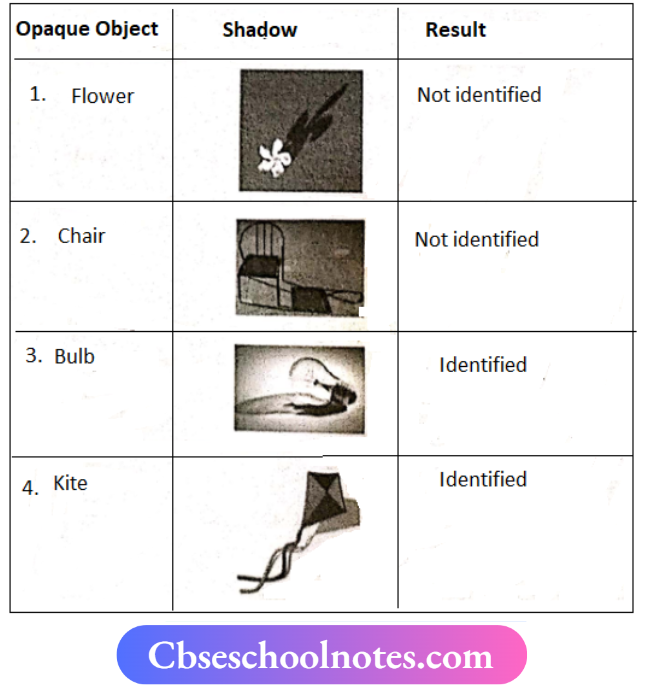
Conclusion:
We have concluded from the above table that the shapes of shadow is not exactly those of the object, it can also mislead us about the object. So, we can’t always identify an object through its shadow
Activity 3
Aim:
To show that a screen is required for a shadow to be formed.
Materials Required:
A torch, an open ground, a paper sheet, etc.
Procedure:
- In the evening, take a torch and a large sheet of paper and go with your friends to an open ground.
- Direct the torch light towards the face of friend A.
- Observe if you can see any shadow behind him, you will probably not see any shadow.
- Now, ask friend B to hold a paper sheet behind friend A. This time, you will be able to see the shadow on the sheet.
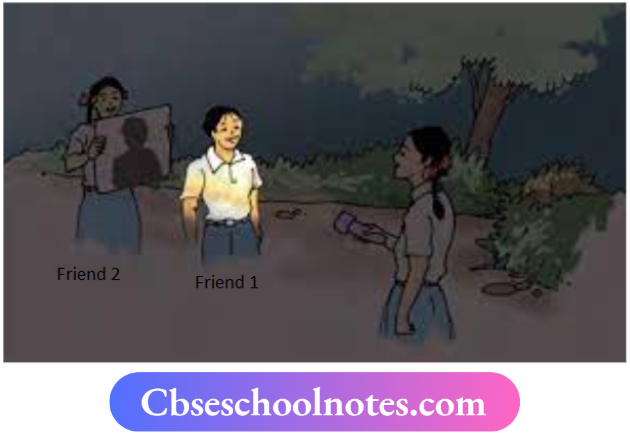
Conclusion:
Conclusion Through this activity, we have concluded that a shadow can be seen only when there is a screen behind an object.
Activity 4
Aim:
To know that shadow gives an accurate picture of the shape, size and colour of an object.
Materials Required:
Some opaque objects like balls, tables, chairs, books, etc., and sheets of paper.
Procedure
- Firstly spread the paper sheets on the ground under sunlight.
- Hold the flower In the sunlight and observe the shape of the shadow formed on the paper sheet.
- Similarly, hold the colour balls one by one In the sunlight and observe the colour of shadows formed on the paper sheet.
- Similarly, hold the bottle at different angles and observe the length of shadows formed
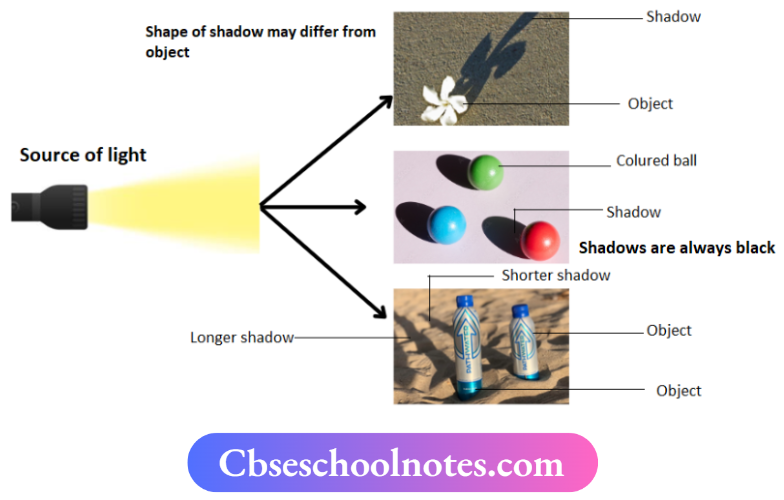
Conclusion:
- Through step 2, we have concluded that some objects look similar to the shadows but some look very different.
- Through step 3, we have concluded that we cannot the colour of objects through shadows because shadows are always black.
- Through step 4, we have concluded that at different angles sizes of shadows are different.
So, finally, we can say that shadow cannot give the accurate shape, size and colour of the object.
Activity 5
Aim:
To make your pinhole camera.
Materials Required:
Two boxes, of tracing paper.
Procedure:
- Take two boxes such that one can slide into another with no gap in between them.
- Cut open one side ofeach box and on the opposite face ofthe larger box, make a small hole in the middle.
- In the smaller box, cut out a square from the middle with a side of about 5 to 6 cm and cover this open square in the box with tracing paper
- Slide the smaller box inside the larger one with the hole, in such a way that the side with the tracing paper is inside.
- Now, your pinhole camera is ready for use.
- Move the smaller box forward or backwards till you get a picture on the tracing paper pasted at the other end.
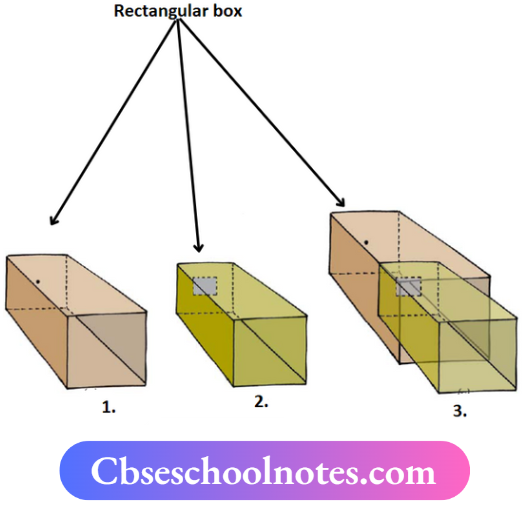
Conclusion:
We have concluded the following observations
1. Pinhole images are inverted images of the object
2. The size of the image decreases as we decrease the distance between the screen and the pinhole.

3. The size of the image increases as we increase the distance between the screen and the pinhole.
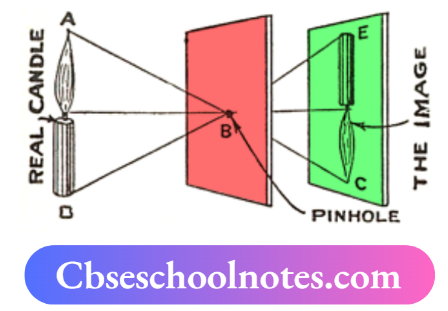
Activity 6
Aim: To show that light travels in a straight line.
Materials Required: A rubber tube or pipe and a candle.
Procedure
- Take a rubber tube or a pipe and fix a burning candle on the table.
- Try to see the flame of the candle through the hole in the pipe, you will be able to see it.
- Now bend this pipe a little and again try to see the flame of the candle through the pipe, you will not be able to see it.
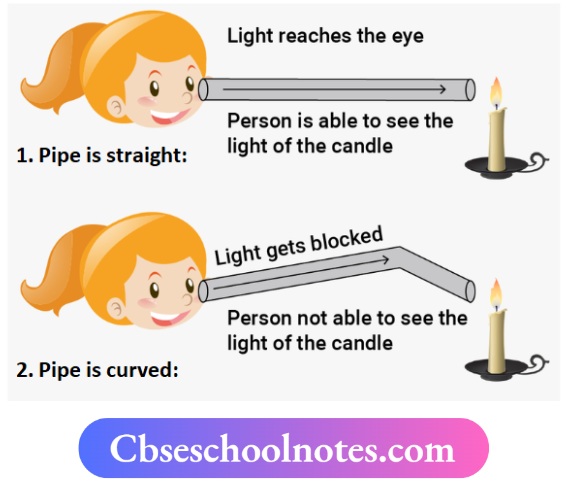
Conclusion:
We have concluded that light travels in a straight line and cannot pass through a curved line.
Activity 7
Aim:
To show that the mirror changes the direction of light that falls on it
Materials Required:
A mirror, a source of light.
Procedure:
1. This activity involves three people and has to be done in a dark room or at night.
- The first person holds the torch and stands in a corner.
- The second person holds a mirror and stands at an angle.
- A third person stands away from both people.

2. Now direct a small beam of light on the mirror; A patch of light will appear on the other side of the room.
3. Adjust the torch in such a way that the patch of light falls on the third person in the room.
Conclusion:
We have concluded that the light is getting reflected by the mirror and the mirror can change the direction of the light beam falling on it.
Activity 8
Aim:
To show that light travels in a straight line and gets reflected from a mirror.
Material required:
A torch, comb, mirror, a cardboard box and sheets.
Procedure:
- Fix a comb and a plane mirror on a cardboard box
- Spread the sheet of coloured paper at the base.
- Switch ON the torch and observe the beam of light falling on the mirror and getting reflected on paper.’

Conclusion:
We have concluded that light rays travel in a straight line and bounce off at the same angle from the mirror
